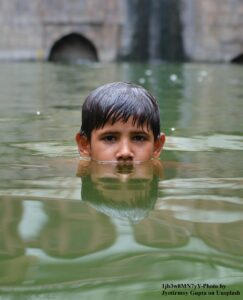Post By: Vishwanath Iyer Published on: December 6, 2016 Reading time: 6 minutes
Śaucam is hygiene. Itconsists of bahira-śaucam (external hygiene) and āntara-śaucam (internal hygiene).
This aspect consists of performance of ablutions regularly, maintaining a clean body and clean environment, all of which are required to ensure external hygiene.

Anecdote 1– In India – snānam (bath) wetting the body completely. There are 9 apertures on the body (mouth, eyes, ears, nostrils, anus and genitals) and all must be thoroughly cleaned. The act of water falling on the body + rubbing action of the hands on the body increases blood flow to the skin resulting in a feeling of increased freshness and awareness.
Traditional Judaism divides ritual washing into two categories, Tevilah (full body immersing or mikvah) and Netilatyadayim (washing in a cup). Importantly, the water used in Mikvah should be directly sourced from a fresh water body such as a river or sea.
After awakening in the morning or after a nap, one is expected to wash one’s hands by pouring water over one’s fingers thrice while reciting a blessing.
Washing performed with a blessing, prior to eating any meal. This is done without blessing after touching an impure object such as ones private parts, shoes, animal etc.
Mayimacharonim (‘After-waters’): Washing one’s hands after a meal
Almost all major illnesses which result in lost time and cost come from lack of awareness of the criticality of hygiene. In fact, spitting, defecation, urination and other practices such as smoking chewing tobacco etc. result in water-borne diseases such as cholera, typhoid, leptospirosis and air-borne diseases such as throat infection etc. Clearly, an individual is responsible, not just for his own health, but also for the health of his neighbor and society at large.

Example: In 1330s, a plague hit China and spread to Europe in 1347 and by 1351 had reached all corners of Europe and the Middle East. It had the effect of killing around 35% of Europe’s population (35 million people in 2 yrs). Overall, it reduced the world’s population from 450 million to between 350 and 375 million.
During this time it was noticed that Jews, living in Ghettos, away from the village suffered lower deaths. This was on account of strict Rabbinical Laws on cleanliness followed by them. They drew water from wells in their backyard and not community wells. This lead to greater control over bacterial infection. Also, injunctions on personal hygiene and disposal of waste ensured that the carriers, rats were less likely to infect the community.
Clearly, this ritual practice protected Jews long before antiseptics and understanding of germs.
In India, there are strict rules for cleanliness, especially when eating. Indians eat only with the right hand. Eating from another person’s plate, something that has come in contact with your mouth, your saliva or your plate is not allowed and called ‘jootha’ (in North India), ‘ushth’ (in Western India), ‘etho’ (in Bengal), ‘aitha’ (in Orissa), ‘echal’ (in Tamil Nadu), ‘enjulu’ (in Karnataka), or ‘engili’ (in Andhra Pradesh).
In many parts of India, after touching any food that has been cooked, one is not allowed to touch lacto based ghee, milk, curds etc. unless the hands have been washed, to avoid contamination of vegetable with animal products and vice-versa.
It is also normal in many parts of India to separate utensils for cooking utensils from serving utensils and eating utensils.
Internal cleanliness (āntara-śaucam) is continuous discarding of baggage so that the person feels light, clear headed and free from anxiety of self-worth (asmitā).
Every experience leaves behind a residue of positive and negative memory and learning. This occurs because we superimpose and compare every experience with existing impressions and expectations (dharma). We make judgements that very often are bipolar – dvandva (like/dislike, good/bad, true/false etc.). These biases often get carried over to the next experience, thereby clouding judgement in other situations also.
Internal cleanliness (āntara-śaucam) comprises keeping the psychosomatic system close to the condition of homeostasis. This is done by continuously purging the self-worth (asmitā) before, during and after each transaction using prāṇāyāma, dhyāna and auto-suggestion. Consequently, the auto-cleansing ensures that we are continuously removing previous biases and preparing ourselves to be willing receptacles of the next experience.
The major impact of śaucam is on our awareness. This occurs at 2 levels:
So, when we consciously, remove the residue of our experience, we retain the learning without the sentiment, thereby becoming a more wholesome person.
Internal Tags: Karma, Dharma (conditioning), Stress and Situational Awareness, Stress and prana, Awareness measures, Bhakti Yoga fundamentals, Jnana Yoga, Karma Yoga, Hatha Yoga and Raja Yoga.
External Tags: Consciousness